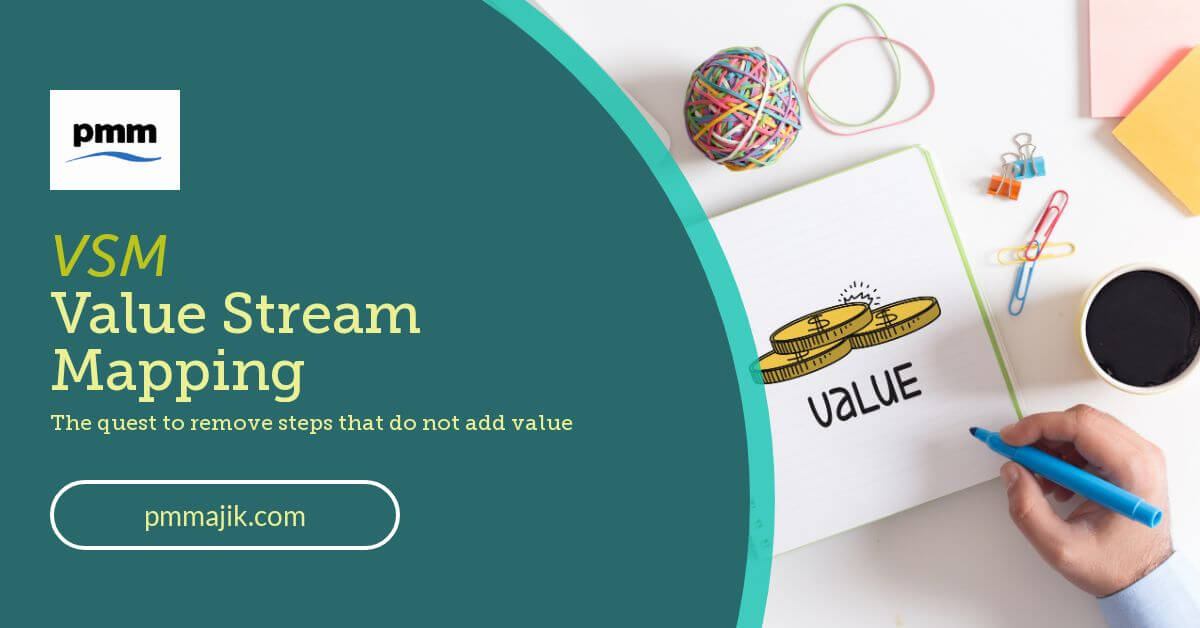In the article about Overview Lean Project Management, you’ll remember that it referred to value stream mapping (VSM).
This article will explore this technique in more detail and identify how it can be useful in your projects.
What is Value Stream Mapping?
VSM is a lean manufacturing technique, which is used to analyse, design and manage the process of bringing a product to the customer.
The flow of work and information are depicted by a standard set of symbols, and items are mapped based on whether or not they add value from the customer’s point of view. The aim is to identify and remove items that don’t add value.
Value Stream Mapping in the Project Environment
Despite its roots in manufacturing, and in particular, the assembly line, VSM has been adapted to fit knowledge-based projects.
It is used to improve processes which involve repeatable steps and multiple hand-offs
Creating a VSM
The following seven steps identify how a VSM is created.
Understand value
Identify the start and end point
Firstly, the start and end point should be mapped; this indicates your internal process. Whilst some teams may map the whole process to show the bigger picture, it isn’t usually possible to control external processes.
The starting point will typically be the delivery of materials, with the delivery to the customer being the end point.
If the team is dealing with complex processes, then they may decide to map each process in more detail. In this case the starting point is the process which allocates the work and the end point is the process which receives it.
Determine the steps
Next, the team will define the steps needed to get from the start to the end point.
Add information flows
Information flows are one of the great advantages of VSM. Each part of the process that leads from the start to the end point needs information to get there. This may be information about sales, how often orders need to be placed with suppliers, and how this is done. How often are customers placing orders? This should all be recorded on the map.
Collect critical data
Having the basics noted is a step in the right direction. Now the processes need to be explored in-depth. This will be informed by company data, which may exist already, or may need to be researched by the team. Some points to consider are:
- Each processes’ inventory
- The cycle time per unit
- Transfer time
- The number of people required at each step in the process
- The pack size and overall batch size
Map data and time lines
All of the information gathered can now be added to the map, ensuring that any historical data used has been verified using current inputs and outputs.
Seven wastes of lean
Now the VSM is complete it is important to use it for its main purpose, identifying waste. Following the seven wastes of lean can help with this. They include:
- Transport
- Inventory
- Motion
- Waiting
- Over-processing
- Overproduction
- Defects
Create an ideal VSM
Now all of the wastages have been identified, create an ideal VSM, detailing how the processes should look.
Remember that an ideal map is unlikely to be reached in just one step. A number of intermediate maps may need to be created, identifying milestones to be reached, which will lead to your overall, ideal VSM.
Benefits
Waste reduction
Reducing and eliminating waste is a key aim of lean management, streamlining the process and improving the company’s bottom line. VSM will help discover not only the root cause of the waste, but the source.
Improved communication
Identifying wasteful hand-offs will enable the team to improve their communication and collaboration, in addition to the behaviour and culture of the team.
The customer is key
Rather than using individual opinions of how the process should be managed, the team prioritise based on the customer’s point of view.
Potential pitfalls
To ensure that VSM doesn’t itself become wasteful, the following pitfalls should be considered.
Level of effort
The level of effort required to conduct the VSM should be matched against the potential value and savings that it will generate. This can be determined by carefully monitoring the return on investment.
Requires experience
The mapping process can be complex, and, in large organisations, cross-functional. Conducting the VSM can therefore require the involvement of experienced project staff.
Lack of bottom line improvement
It is often assumed that making small improvements here and there will mount up to a big improvement overall. Making small steps will of course produce savings; however, it may not translate directly to the bottom line until the full VSM has been completed.
Forget professional tools
Creating a VSM is about reducing waste, not creating it. Don’t reach for professional tools, charts and symbols straight away, a basic pen and whiteboard are sufficient to create an initial map.
As with any continuous improvement process, they key is to keep improving! The process should be continually mapped as there is always room for more improvement in the aim for operational excellence.
Creating a VSM helps to identify items in the process which don’t add value from the customer’s point of view. Being able to determine where those wastages occur will help the team to eliminate or reduce them and improve the overall process.
